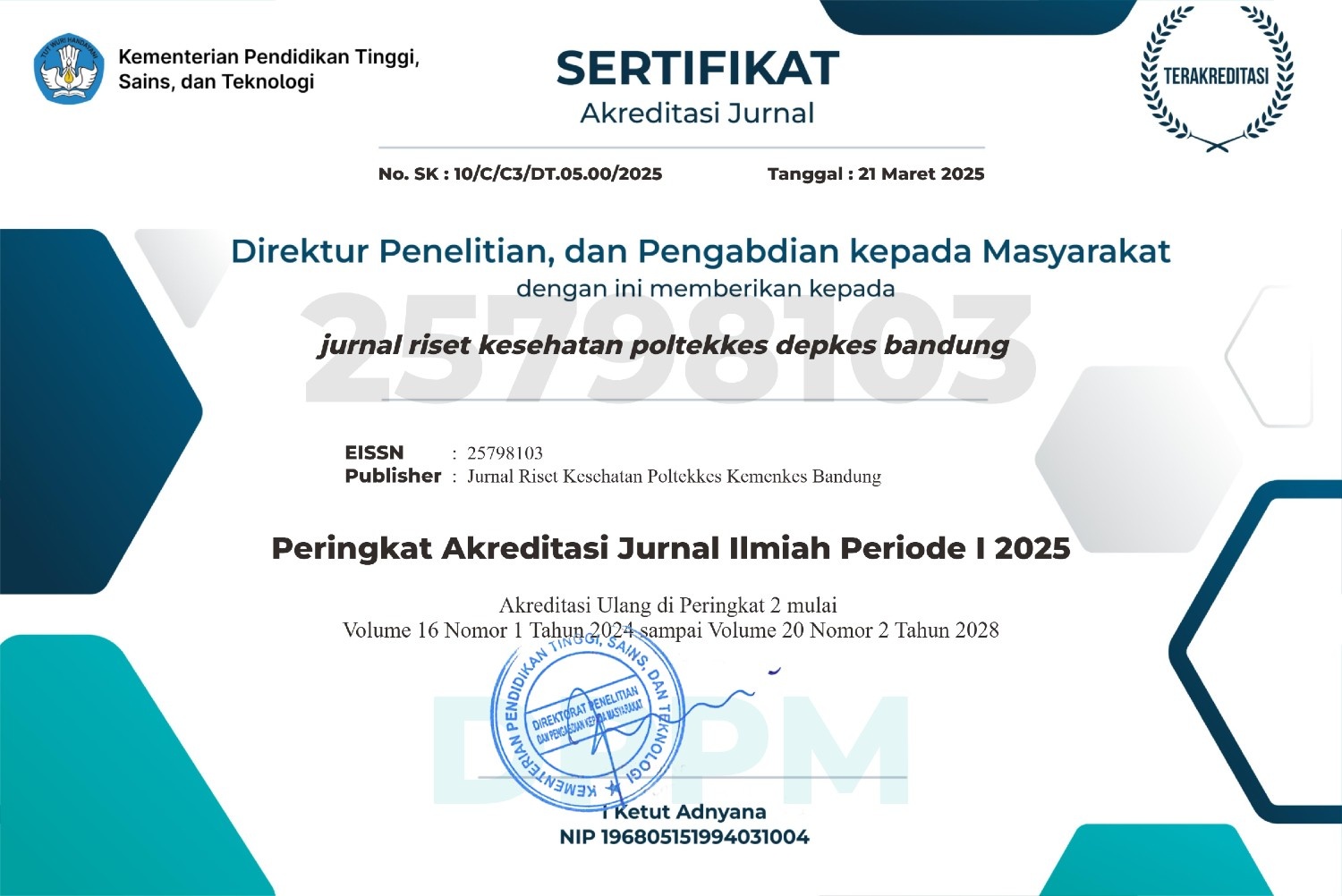PEMANFAATAN SERBUK GERGAJI SEBAGAI ADSORBEN DALAM MENYISIHKAN KANDUNGAN PB (TIMBAL) LIMBAH OLI
DOI:
https://doi.org/10.34011/juriskesbdg.v15i2.2192Keywords:
Adsorption capacity, adsorbentAbstract
Oil was one of the hydrocarbon pollutants. Waste oil generally consists of water, crude oil, and solid particulate matter. Hazardous substances and other toxic materials contained in waste oil make this waste must be treated to reduce its toxicity. Pb or lead was a toxic substance produced from industrial activities using oil, painting, agrochemicals, etc. The study aimed to determine the ability of the sawdust adsorbent to remove the heavy metal lead (Pb) in waste oil. This research method was a laboratory-scale quasi-experiment for field applications. The population was all oil waste taken by the grab sample method, while the sample was part of the waste. Treated and controlled oil. The non-parametric test results showed that there was a difference in the average Pb content in the waste oil after being treated with various doses of sawdust adsorbent (p value=0.008). The amount of removal of Pb content in waste oil was in the range of 66.55-91.24%. It can be concluded that sawdust adsorbent can remove Pb in waste oil.
Downloads
References
Nurhidayanti N, Arinih C. Kajian Pengelolaan Limbah Bahan Berbahaya Dan Beracun (B3) Pt. Ytk Indonesia. J Ilm Inform Arsit dan Lingkung. 2019;14(2):93-102.
Perlindungan Dan Pengelolaan Lingkungan Hidup. Undang - Undang Republik Indonesia Nomor 32 Tahun 2009. Published online 2009:12-42.
Bayat Z, Hassanshahian M, Cappello S. Immobilization of Microbes for Bioremediation of Crude Oil Polluted Environments: A Mini Review. Open Microbiol J. 2015;9:48-54. doi:10.2174/1874285801509010048
Vicharana Intrakamhaeng, Kyle A. Clavier TGT. Hazardous waste characterization implications of updating the toxicity characteristic list. J Hazard Mater. 2020;383(121171).
Hui K, Tang J, Lu H, Xi B, Qu C, Li J. Status and prospect of oil recovery from oily sludge:A review. Arab J Chem. Published online 2018;13(8): 6523-6543. doi:10.1016/j.arabjc.2020.06.009
Kumar A, Kumar A, Cabral-Pinto M, et al. Lead toxicity: Health hazards, influence on food Chain, and sustainable remediation approaches. Int J Environ Res Public Health. 2020;17(7):1-33. doi:10.3390/ijerph17072179
Igwegbe CA, Umembamalu CJ, Osuagwu EU, Oba SN, Emembolu LN. Studies on Adsorption Characteristics of Corn Cobs Activated Carbon for the Removal of Oil and Grease from Oil Refinery Desalter Effluent in a Downflow Fixed Bed Adsorption Equipment. Eur J Sustain Dev Res. 2020;5(1):1-14. doi:10.29333/ejosdr/9285
Kumar A, Gupta H. Activated carbon from sawdust for naphthalene removal from contaminated water. Environ Technol Innov. 2020;20(1):101080. doi:https://doi.org/10.1016/j.eti.2020.101080
Widi Astuti BK. Adsorpsi Pb2+ dalam Limbah Cair Artifisial Menggunakan Sistem Adsorpsi Kolom dengan Bahan Isian abu Layang Batubara Serbuk dan Granular. J Bahan Alam Terbarukan. 2015;4(1):27-33. doi:10.15294/jbat.v4i1.3769
Nisak K. Pemanfaatan Limbah Kulit Pisang Kepok (Musa Acuminate L.)Sebagai Bioadsorben Timbal (Pb) Dengan Sistem Kontinyu.; 2022. Universitas Islam Negeri Sunan Ampel Surabaya.
Widayatno T, Yuliawati T, Susilo AA, et al. Adsorpsi Logam Berat (Pb) dari Limbah Cair dengan Adsorben Arang Bambu Aktif. J Teknol Bahan Alam. 2017;1(1):17-23.
Meez E, Hosseini-Bandegharaei A, Rahdar A, Thysiadou A, Matis KA, Kyzas GZ. Synthetic oil-spills decontamination by using sawdust and activated carbon from aloe vera as absorbents. Biointerface Res Appl Chem. 2021;11(4):11778-11796. doi:10.33263/BRIAC114.1177811796
Irawan C. Pengaruh Konsentrasi Adsorbat Terhadap Efektivitas Penurunan Logam Fe Dengan Menggunakan Fly Ash Sebagai Adsorben . Seminastika. Published online 2018:291-293.
Taty-Costodes VC, Fauduet H, Porte C, Ho YS. Removal of lead (II) ions from synthetic and real effluents using immobilized Pinus sylvestris sawdust: Adsorption on a fixed-bed column. J Hazard Mater. 2005;123(1-3):135-144. doi:10.1016/j.jhazmat.2005.03.032
Biswas S, Mishra U. Continuous Fixed-Bed Column Study and Adsorption Modeling: Removal of Lead Ion from Aqueous Solution by Charcoal Originated from Chemical Carbonization of Rubber Wood Sawdust. J Chem. 2015;2015:1-9. doi:10.1155/2015/907379
Suwazan D, Nurhidayanti N. Efektivitas Kombinasi Kitosan dan Ampas Teh Sebagai Adsorben Alami dalam Menurunkan Konsentrasi Timbal Pada Limbah Cair PT PXI. J Ilmu Lingkung. 2022;20(1):37-44. doi:10.14710/jil.20.1.37-44
Intan D, Said I, Abram H. Pemanfaatan Biomassa Serbuk Gergaji Sebagai Penyerap Logam Timbal (The Utilization of Sawdust Biomass as Adsorbent for Lead Metal). J Akad Kim. 2016;5(4):166-171.
Downloads
Published
How to Cite
Issue
Section
License
Copyright (c) 2023 JURNAL RISET KESEHATAN POLTEKKES DEPKES BANDUNG

This work is licensed under a Creative Commons Attribution-NonCommercial-NoDerivatives 4.0 International License.









